Intel Core Ultra 7 155UL

The Intel Core Ultra 7 155UL processor is an impressive addition to the Intel lineup, offering a powerful combination of performance and energy efficiency. With a total of 12 cores and 14 threads, this processor is capable of handling demanding tasks with ease, making it an excellent choice for a variety of desktop computing needs. The 7 nm technology ensures that the processor operates efficiently, while the 15W TDP makes it a great option for those looking to build a system with lower power consumption.
The base frequency of 1.7 GHz provides solid performance for everyday computing tasks, while the max turbo frequency of 4.8 GHz allows the processor to ramp up for more demanding workloads. The 12 MB of L3 cache ensures that data is accessed quickly, further enhancing the overall performance of the processor.
Additionally, the integrated graphics model offers decent graphics performance for light gaming and multimedia tasks, making the Intel Core Ultra 7 155UL a versatile option for a range of users. Overall, this processor is a solid choice for those looking for a balance of performance and energy efficiency in their desktop systems.
Basic
Label Name
Intel
Platform
Desktop
Launch Date
April 2024
Model Name
?
The Intel processor number is just one of several factors - along with processor brand, system configurations, and system-level benchmarks - to be considered when choosing the right processor for your computing needs.
Core Ultra 7 155UL
Code Name
Meteor Lake-PS
Foundry
Intel
Generation
Ultra 7 (Meteor Lake)
CPU Specifications
Total Cores
?
Cores is a hardware term that describes the number of independent central processing units in a single computing component (die or chip).
12
Total Threads
?
Where applicable, Intel® Hyper-Threading Technology is only available on Performance-cores.
14
Performance-cores
2
Efficient-cores
10
Performance-core Base Frequency
1.7 GHz
Efficient-core Base Frequency
1200 MHz
Efficient-core Max Turbo Frequency
?
Maximum E-core turbo frequency derived from Intel® Turbo Boost Technology.
3.8 GHz
Performance-core Max Turbo Frequency
?
Maximum P-core turbo frequency derived from Intel® Turbo Boost Technology.
4.8 GHz
L1 Cache
112 KB per core
L2 Cache
2 MB per core
L3 Cache
12 MB shared
CPU Socket
?
The socket is the component that provides the mechanical and electrical connections between the processor and motherboard.
Intel Socket 1851
Bus Frequency
100 MHz
Multiplier
17.0
Unlocked Multiplier
No
Technology
?
Lithography refers to the semiconductor technology used to manufacture an integrated circuit, and is reported in nanometer (nm), indicative of the size of features built on the semiconductor.
7 nm
TDP
15 W
PCIe Version
?
PCI Express is a high-speed serial computer expansion bus standard used for connecting high-speed components, replacing older standards such as AGP, PCI, and PCI-X. It has gone through multiple revisions and improvements since its initial release. PCIe 1.0 was first introduced in 2002, and in order to meet the growing demand for higher bandwidth, subsequent versions have been released over time.
4
Memory Specifications
Memory Type
?
Intel® processors come in four different types: Single Channel, Dual Channel, Triple Channel, and Flex Mode. Maximum supported memory speed may be lower when populating multiple DIMMs per channel on products that support multiple memory channels.
DDR5
Depends on motherboard-5600
Memory Channels
?
The number of memory channels refers to the bandwidth operation for real world application.
2
ECC Memory Support
No
GPU Specifications
Integrated Graphics Model
?
An integrated GPU refers to the graphics core that is integrated into the CPU processor. Leveraging the processor's powerful computational capabilities and intelligent power efficiency management, it delivers outstanding graphics performance and a smooth application experience at a lower power consumption.
Arc Xe-LPG 64EU
Miscellaneous
PCIe Lanes
8
Share in social media
Or Link To Us
<a href="https://cputronic.com/en/cpu/intel-core-ultra-7-155ul" target="_blank">Intel Core Ultra 7 155UL</a>